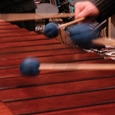This classic from our archives first appeared in December 1965.
Technique on mallet instruments (xylophone, marimba, vibraphone, and bells) is about 90% based on the use of alternating single strokes as the means of manipulating the mallets. This is as it should be, for the single stroke provides the most rhythmic and least complicated method of moving over the instrument. Single-stroke technique must be thoroughly mastered as a basis for performing on the mallet-played instruments.
However, the use of the double stroke – two strokes in a row with the same hand – is also an important mallet technique. A double stroke in a logical place can facilitate the execution of a passage that would be awkward if played using alternating strokes exclusively. It basically minimizes time and motion in getting to the next pitch.
One should not confuse the term double stroke with the expression rebound stroke. The double stroke uses two distinctly executed wrist strokes with the same hand, both the first and second notes identical in attack and in method of execution. The rebound stroke uses one basic wrist motion, with the second stroke being a rebound of the first and not identical with the first in attack or in method of execution. Although the rebound can be controlled with the use of the fingers and can be executed faster than the double stroke, it is of little value to mallet players, because it lacks the clarity and consistency of volume of the double stroke.
.jpg)
The above example is froma transcription of the Bach Sonata No. VI for Unaccompanied Violin and provides an excellent example of how using only alternated strokes would tie the player’s hands in a knot. Regardless of which hand starts the passage, the player’s hands, if completely alternated, would have to cross each other in such a way as to make the passage unplayable. The only sensible way to play this section is to insert double strokes at key points, as illustrated.
The example is only one instance, but there are many in which the use of a good double stroke can be employed. It takes practice to develop a good double stroke. The following are a few possible technique studies for developing this stroke.
.jpg)
The above exercise is to be repeated numerous times. Play first with single strokes, then on the repeat with double strokes, then on the next repeat with single strokes again, continuing this pattern. It is a good exercise because it gives one a chance to match the sound of the single and double strokes. The exercise should be practiced slowly until the strokes match in all respects. Then it should be practiced at faster tempos, but always with the goal of achieving perfectly matched in sound and height strokes. Accenting the second stroke is another way of strengthening it.
One of the best ways to develop a good double stroke is to work on a good triple stroke.
.jpg)
________________________________________________________________
.jpg)
________________________________________________________________________
.jpg)
The above two exercises are good for developing facility and control with various intervals by use of the double stroke. Again, students must practice for clarity, not speed, and must use a double stroke, not a rebound stroke.
.jpg)
____________________________________________________________________
.jpg)
All the above exercises can be transposed into all major and minor keys. Students should use as much variation as possible, practicing at various tempos, with various dynamics. In other words, they should become flexible.
The following are a few points to remember regarding the use of the double stroke:
• If possible, select small intervals for the use of this stroke.
• Be sure to use a real double stroke and not a rebound stroke.
• Most importantly, do not use the double stroke unnecessarily.
The above examples are only a few exercises that will be useful to the student in developing the double stroke. The number of exercises is infinite. Mallet Control by George Stone is one good source of exercises. The student should also be taught to invent his own exercises. However, he must always work for clearness and not speed. He must develop a sensitive ear and become his most severe critic. Such matters as consistency in volume and avoidance of the node of the bar can best be check with a recording device to assist the ear in discriminating more acutely.





